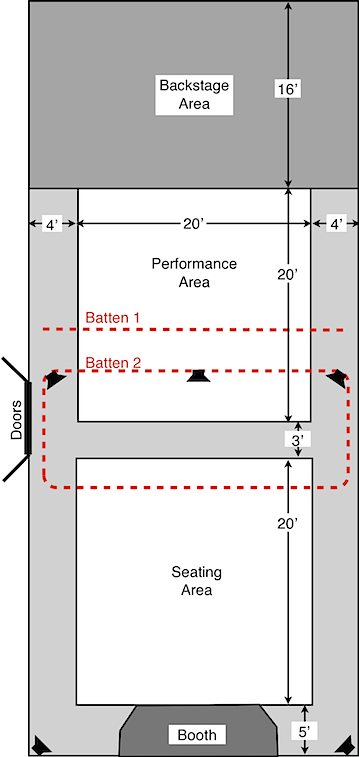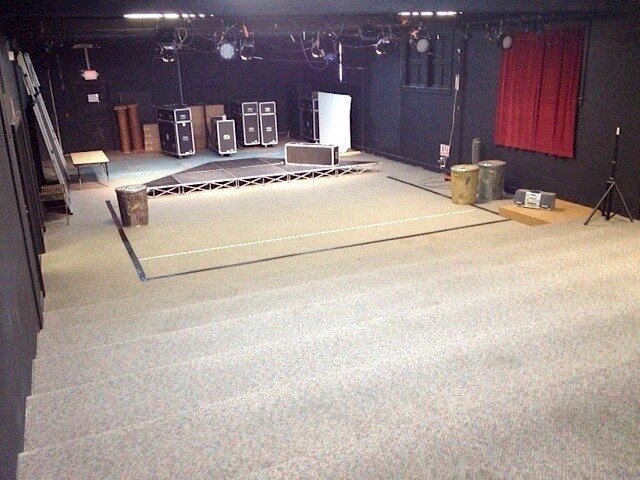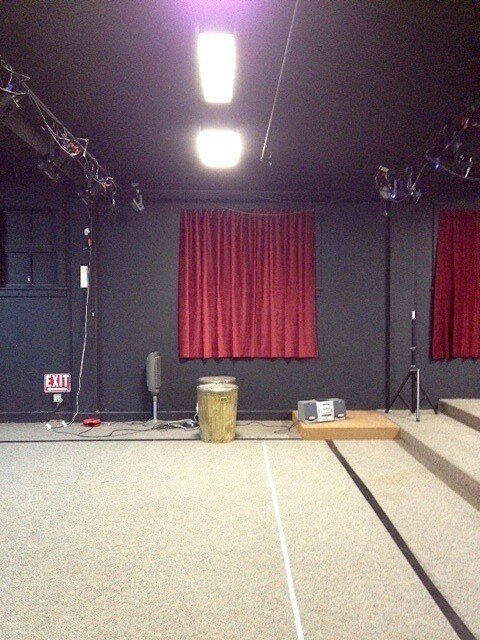BryanKerr
Member
Hello Everyone,
Our K-12 school just got access to a black box theater that we used to lease out to another school. Of course, they stripped it of all their gear, so I need to a sound system in there. I need help designing a system given the info below.
The Room
I've attached a sketch of the theater. It's 28' wide by 64' long. The ceiling is about 12' high above the performance and backstage area. The seating area steps up as you go away from the stage toward the booth so that at the back of the theater, the ceiling's about 7.5' high.
Except for the concrete backstage area, the floor is carpeted. We use folding chairs for our seating, and use a combination of modular Intellistage platforms and Wegner Flipforms for our stage.
Uses
The theater is primarily intended for small to medium size play productions such as "The Jungle Book" for K-6, and "Little Shop of Horrors" for High School. Canned backing music will be used for little kid productions (Jungle Book), while other productions (Little Shop) will use simple live instrumentation like keys and drums.
Movies will also be shown in the theater, and live music ("rock band") will be performed there as well. Though I'll use our JBL SRX712s and 718s for the rock performances.
What We Have
24 channels of Shure ULXP4 transmitters and receivers
24 Countryman E6 head mics
Yamaha LS9-32
3 DBX IEQ31 units (6 channels)
Requirements
Headmics - While the theater is small enough to forego amplifying the actors, the fact is that not everyone here projects like a professional actor. So our drama and music directors really want all our actors using the E6 mics. For the little kids productions it's not as important as we all recognize they're too young to use the mics.
Surround - The drama head would like me to do some sound design with "surround" sound effects if possible.
What I Need From You All
So I need help figuring out what speakers I need for the house and where to put them. And I also need some advice about providing some monitoring for the actors (should I fly speaker on Batten 1)? Amp recommendations would also be appreciated.
In the attached sketch, you can see where our electrical battens are, and where I've proposed to place 5 speakers. You'll also notice that the performance area comes out a bit in front of where I proposed to place the speakers. I want to make sure the speakers are far enough upstage so the front of the audience gets adequate coverage, but I'm also worried about feedback into the actors' headmics.
In terms of budget, our school's admin has asked for our "wishlist." I don't want to give them sticker shock though, so if I could keep it in the $5,000-10,000 range (including cables, amps, mounting hardware, etc.), that probably be best.
Also, if we're serious about using 5.1 for the movies as well, I should probably factor in a couple of subs.
In my research, I've come across the AcousticDesign AD-S82, EAW VR61, JBL AC15/16, and EV ZX1 as possible options. Am I on the right track?
Thanks for all your help!
Our K-12 school just got access to a black box theater that we used to lease out to another school. Of course, they stripped it of all their gear, so I need to a sound system in there. I need help designing a system given the info below.
The Room
I've attached a sketch of the theater. It's 28' wide by 64' long. The ceiling is about 12' high above the performance and backstage area. The seating area steps up as you go away from the stage toward the booth so that at the back of the theater, the ceiling's about 7.5' high.
Except for the concrete backstage area, the floor is carpeted. We use folding chairs for our seating, and use a combination of modular Intellistage platforms and Wegner Flipforms for our stage.
Uses
The theater is primarily intended for small to medium size play productions such as "The Jungle Book" for K-6, and "Little Shop of Horrors" for High School. Canned backing music will be used for little kid productions (Jungle Book), while other productions (Little Shop) will use simple live instrumentation like keys and drums.
Movies will also be shown in the theater, and live music ("rock band") will be performed there as well. Though I'll use our JBL SRX712s and 718s for the rock performances.
What We Have
24 channels of Shure ULXP4 transmitters and receivers
24 Countryman E6 head mics
Yamaha LS9-32
3 DBX IEQ31 units (6 channels)
Requirements
Headmics - While the theater is small enough to forego amplifying the actors, the fact is that not everyone here projects like a professional actor. So our drama and music directors really want all our actors using the E6 mics. For the little kids productions it's not as important as we all recognize they're too young to use the mics.
Surround - The drama head would like me to do some sound design with "surround" sound effects if possible.
What I Need From You All
So I need help figuring out what speakers I need for the house and where to put them. And I also need some advice about providing some monitoring for the actors (should I fly speaker on Batten 1)? Amp recommendations would also be appreciated.
In the attached sketch, you can see where our electrical battens are, and where I've proposed to place 5 speakers. You'll also notice that the performance area comes out a bit in front of where I proposed to place the speakers. I want to make sure the speakers are far enough upstage so the front of the audience gets adequate coverage, but I'm also worried about feedback into the actors' headmics.
In terms of budget, our school's admin has asked for our "wishlist." I don't want to give them sticker shock though, so if I could keep it in the $5,000-10,000 range (including cables, amps, mounting hardware, etc.), that probably be best.
Also, if we're serious about using 5.1 for the movies as well, I should probably factor in a couple of subs.
In my research, I've come across the AcousticDesign AD-S82, EAW VR61, JBL AC15/16, and EV ZX1 as possible options. Am I on the right track?
Thanks for all your help!







